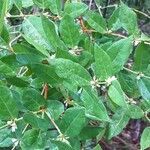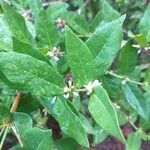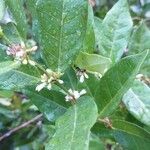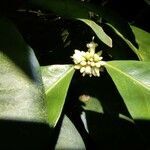Leaves 2–11.5(15.5) × 1–4.2(4.7) cm, elliptic, oblong-elliptic or lanceolate, ± acute, the actual apex ± obtuse, less often acuminate (in some cultivated specimens), cuneate to subcordate at the base, thinly coriaceous, glabrous, often with pale minute white specks particularly near the midrib above; petiole 5–9 mm long; stipules 2.5–4 mm long, triangular, keeled, glabrous.
Inflorescences sessile or practically so, the two opposite together forming a globose cluster up to 1.5 cm in diameter, or peduncles up to 4 mm long in one variant; components quite glabrous outside or almost imperceptibly puberulous; bracteoles cupular, tightly surrounding the calyx base, c. 1 mm tall.
A shrub or small tree. It grows 1-10 m high. The leaves are narrowly oval and the base is rounded or wedge shaped. They are 3-13 cm long by 2-4 cm wide. The flowers are white and in dense clusters. The fruit are round and 7-9 mm across. They are carried in clusters. They are white, red or black.
Calyx 1.5(2) mm long, shallowly cup-shaped, glabrous outside or imperceptibly puberulous or in one variant silky pubescent, glabrescent to densely pubescent inside, often with pale marks outside, usually truncate, sometimes undulate or faintly toothed or becoming lacerate.
Corolla white; tube (2)4 mm long, glabrous outside or appressed puberulous in one variant, densely white hairy at the throat; lobes 1.5–2 mm long and wide, ovate.
Fruits 7–9 mm in diameter, globose, glabrous, ± white-dotted, somewhat didymous.
Shrub or small tree 1–3(4.5) m tall, occasionally weak and almost trailing.
Stems glabrous, the bark peeling in long strips on older stems.
Seeds about 6 × 4 mm, ± semiglobose.
Style densely white hairy.
Flowers sweet-scented.
Disk prominent.





